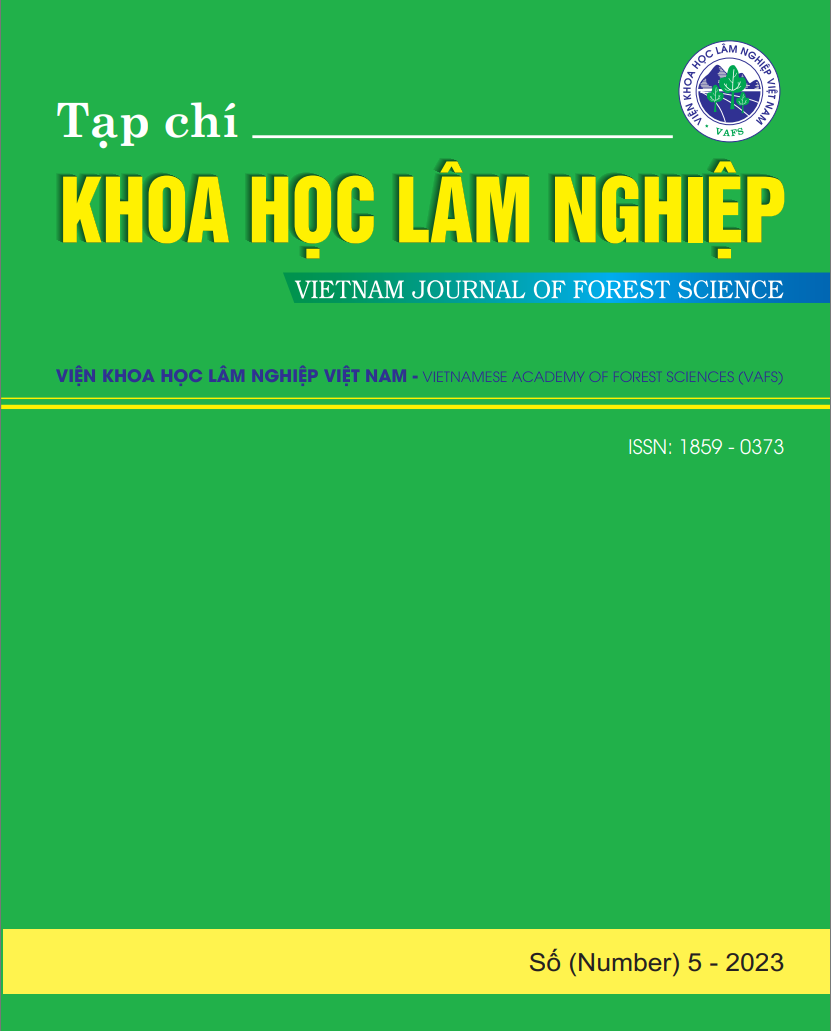PUTATIVE DISEASE AGENTS ON Manglietia conifera Dandy IN NORTHERN VIETNAM
DOI:
https://doi.org/10.70169/VJFS.1077Keywords:
damage incidence, Manglietia conifera, disease agents, damage severity, Northern VietnamAbstract
Manglietia conifera Dandy is a native tree species of high economic value, widely planted in the northern mountainous provinces of Vietnam. However, the rapid expansion of plantation areas in recent years has increased the risk of disease outbreaks, particularly those caused by fungi, algae, and several members of the class Oomycetes. This study was conducted to identify the causal agents and assessed disease incidence and severity on four-year-old M. conifera trees across four provinces: Lao Cai, Yen Bai, Tuyen Quang, and Bac Kan. A total of 16 pathogenic taxa were identified through morphological examination combined with ITS rDNA sequencing, spanning nine orders and 12 families. These pathogens affected multiple plant parts, including leaves, shoots, stems, roots, and branches. Among them, Pestalotiopsis vismiae was the most virulent, causing severe tip blight with disease incidence ranging from 17.5 to 57.5% and disease severity values between 6.6% and 30.0%. Other notable pathogens included Colletotrichum fructicola, Phytophthora × vanyenensis, Fusarium oxysporum, Phoma sp., Meliola sp., and the green alga Cephaleuros virescens. Although most diseases had low severity indices (R %) ranging from 2.2 to 5.3%, the co - occurrence of multiple pathogens across all surveyed sites indicates a high risk of epidemics under favourable environmental conditions. This study provides an important basis for further research on pathogen virulence, disease development conditions, and the formulation of appropriate management strategies in Vietnam.
References
1 Tiêu chuẩn Quốc gia TCVN TCVN 8928:2023 về phòng, chống bệnh hại cây rừng - hướng dẫn chung. https://thuvienphapluat.vn/TCVN/Nong-nghiep/TCVN-8928-2023-Phong-chong-benh-hai-cay-rung-Huong-dan-chung-920522.aspx.
2 Lê Văn Bình, Phạm Quang Thu, Đào Ngọc Quang, Đặng Như Quỳnh, Nguyễn Văn hành, Nguyễn Hoài Thu, Vũ Văn Định, Phạm Duy Long, Nguyễn Mạnh Hà 2021. Danh lục sinh vật ây hại trên 6 loài cây Lâm nghiệp ở Việt Nam. Nhà xuất bản Nông nghiệp, Hà Nội.
3 Boersma, J. G., Cooke, D. E. L., & Sivasithamparam, K., 2000. A survey of wildflower farms in the south - West of Western Australia for Phytophthora spp. associated with root rots. Australian Journal of Experimental Agriculture, 40(7), 1011-1019. DOI: 10.1071/EA00013
4 Dang, Q. N., Pham, T. Q., Arentz, F., Hardy, G. E. S., & Burgess, T. I., 2021. New Phytophthora species in clade 2a from the Asia - Pacific region including a re-examination of P. colocasiae and P. meadii. Mycological Progress, 20(2), 111-129. DOI: 10.1007/s11557-020-01656-7
5 Fu, D. D., Wang, W., Qin, R. F., Zhang, R., Sunb, G. Y., & Gleason, M. L., 2014. Colletotrichum fructicola, first record of bitter rot of apple in China. Mycotaxon, 126(1), 23-30. DOI:10.5248/126.23
6 Ho, H. H., 2018. The taxonomy and biology of Phytophthora and Pythium. J. Bacteriol. Mycol. Open Access, 6, 40-45. DOI: 10.15406/jbmoa.2018.06.00174
7 Hosagoudar, V. B., 2013. Meliolales of India - Volume III. Journal of Threatened Taxa, 3993-4068. DOI: 10.11609/JoTT.o3307.3993-4068
8 Huang, Y. C., Tsai, C. Y., & Wang, C. L., 2023. Host invasion type is a phylogenetically conserved characteristic of Cephaleuros. Plant Disease, 107(10), 3222-3229. DOI: 10.1094/PDIS-10-22-2338-RE
9 Hyde, K. D., Wijesinghe, S. N., Afshari, N., Aumentado, H. D., Bhunjun, C. S., Boonmee, S., ... & Zhang, J. Y., 2024. Mycosphere Notes 469–520. Mycosphere, 15(1), 1294-1454. DOI: 10.5943/mycosphere/15/1/11
10 Khan, M. A., Khan, S. A., Waheed, U., Raheel, M., Khan, Z., Alrefaei, A. F., & Alkhamis, H. H., 2021. Morphological and genetic characterization of Fusarium oxysporum and its management using weed extracts in cotton. Journal of King Saud University-Science, 33(2), DOI: 10.1016/j.jksus.2020.101299
11 Maharachchikumbura, S. S., Guo, L. D., Chukeatirote, E., Bahkali, A. H., & Hyde, K. D., 2011. Pestalotiopsis - morphology, phylogeny, biochemistry and diversity. Fungal diversity, 50, 167-187. DOI: 10.1007/s13225-011-0125-x
12 Lombard, L., Houbraken, J., Decock, C., Samson, R. A., Meijer, M., Réblová, M., ... & Crous, P. W., 2016. Generic hyper - diversity in Stachybotriaceae. Persoonia - Molecular Phylogeny and Evolution of Fungi, 36(1), 156-246. DOI: 10.3767/003158516X691582
13 Lv, W., Yu, Y., Zhong, X., Lin, Y., Guo, G., & Wang, Y., 2023. Identification and characterization of Cladosporium species associated with tea plants (Camellia sinensis) in China. Plant Pathology, 72(5), 868-880. DOI: 10.1111/ppa.13711
14 Pitaloka, M. K., Petcharat, V., Arikit, S., & Sunpapao, A., 2015. Cephaleuros virescens, the cause of an algal leaf spot on Para rubber in Thailand. Australasian Plant Disease Notes, 10, 1-4. DOI: 10.1007/s13314-015-0158-1
15 Sideris, C. P., 1932. Taxonomic studies in the family Pythiaceae II. Pythium. Mycologia, 24(1), 14-61. DOI: 10.1080/00275514.1932.12020607
16 Sunpapao, A., PITALOKA, M. K., & ARIKIT, S., 2016. Algal leaf spot associated with Cephaleuros virescens 1 Ulvophyceae. Biodiversitas Journal of Biological Diversity, 17(1). DOI: 10.13057/biodiv/d170105
17 Tan, X., Zhao, J., Qiao, G., Liu, J., Hsiang, T., Yu, Z., & Qin, W., 2023. Morphological characterization and pathogenicity of Colletotrichum aenigma and C. siamense causing anthracnose on Euonymus japonicus in Beijing, China. Plant Pathology, 72(3), 430-441. DOI: 10.1111/ppa.13681
18 Wikee, S., Lombard, L., Crous, P. W., Nakashima, C., Motohashi, K., Chukeatirote, E., ... & Hyde, K. D., 2013. Phyllosticta capitalensis, a widespread endophyte of plants. Fungal Diversity, 60, 91-105. DOI: 10.1007/s13225-013-0235-8
19 Yu, Y. T., Chen, J., Gao, C. S., Zeng, L. B., Li, Z. M., Zhu, T. T., ... & Zhu, A., 2016. First report of brown root rot caused by Pythium vexans on ramie in Hunan, China. Canadian Journal of Plant Pathology, 38(3), 405-410. DOI:10.1080/07060661.2016.1230150
20 Zhou, Y., Zhang, W., Li, Y., Ji, S., Li, X., Hyde, K. D., ... & Yan, J., 2023. Identification and characterization of Colletotrichum species associated with cherry leaf spot disease in China. Plant Disease, 107(2), 500-513. DOI: 10.1094/PDIS-11-21-2538-RE
21 Liu, H., Sun, C., Zhou, B., Li, D., Song, Q., Liu, J., . . . Zhang, S.-l., 2025. First report of Pestalotiopsis lushanensis causing leaf spot of Manglietia decidua (Magnoliaceae) in China. Plant Disease(ja). DOI: 10.1094/PDIS-04-24-0841-PDN
22 Wang, Q.-H., Ye, R., Zhou, Y., Pan, Y., Hu, T.-Q., Zeng, Y.-C., . . . Zhang, Y., 2023. First report of Colletotrichum siamense causing leaf spot on Manglietia decidua in the world. Plant Disease, 107(2), 562.
23 Yi, R. H., Long, G. G., Li, K. Y., Wang, X. Y., Huang, Y., & Li, D., 2021. First report of southern blight of Manglietia decidua caused by Sclerotium rolfsii in China. Plant Disease, 105(4), 1217-1217. DOI: 10.1094/PDIS-10-20-2194-PDN
24 Yi, R. H., Su, J. J., Li, H. J., Li, D., & Long, G. G., 2022. First report of root rot on Manglietia decidua caused by Calonectria ilicicola in China. Plant Disease, 106(5), 1522. DOI: 10.1094/PDIS-07-21-1467-PDN









